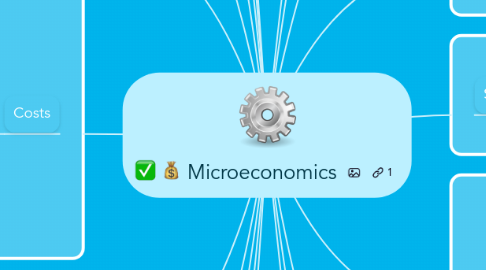
1. Efficiency
1.1. Allocative: correct location of resources
1.2. Productive: + production using - resources as possible
1.3. Economic: mix of both
2. Government Intervention
2.1. Taxes
2.2. Subsidies
3. Price Control
3.1. Price ceiling The government chooses to set a maximum price in a certain good, below the equilibrium price.
3.2. Price floor The government sets a minimum price for a certain good, above the market equilibrium price.
4. Surplus
4.1. Consumer surplus: spend less than you were willing and able
4.2. Producer surplus: receive more than expected
4.3. Social surplus: the sum of both
5. Theory of Firm
5.1. Cost theory
5.1.1. Short run → One factor of production is fixed. Length = time it takes to increase Q of fixed factor. Production is part of the short run.
5.1.2. Long run→ all factors of production variable. When fixed factors are changed short run starts again. Planning is part of it.
6. Marginal benefit
6.1. The benefit you get from the last increase in an unit of a certain product.
7. Costs
7.1. Explicit costs: directly related to production, direct payments for factors of production
7.2. Opportunity cost or Implicit cost: entrepreneur takes a risk to start the business
7.3. Economic cost: both together
7.4. Total cost: cost to produce all of a specified level of output
7.5. Average cost: cost per worker
7.6. Marginal cost: additional cost per additional unit of output
8. Diseconomies of scale: Increases in LRAC that come when firm alters all of its factors of production, in order to increase output.
9. Monopoly: When only one firm has total control over the market.
10. Oligopoly: Has two or more firms dominating the market.
11. Externalities
11.1. Consumption Externalities→ (consuming causing positive/negative externality to a 3rd one)
11.1.1. Positive: If you consume you create welfare for others, for example hybrid cars, you help reduce contamination if you buy one. F.E.: free riding
11.1.2. Negative: Firms→ profiting maximizing→ government rectifies situation w/taxes→ MPC curve moves up
11.2. Production Externalities → (Costs of production must be paid by someone ≠producer of a good)
11.2.1. Positive: As a firm you benefit someone else while producing your product. Creating welfare
11.2.2. Negative: You damage someone else as a result of your production process. Is an implicit cost not taken into account. Having welfare loss.
12. Monopolistic Competition
12.1. Products are differentiated
12.2. Assumptions
12.2.1. many producers and consumers
12.2.2. no perfect substitutes
12.3. Productive efficiency
12.3.1. min. average cost unachieved
12.4. Allocative efficiency
12.4.1. Price> marginal cost
12.4.2. Price < monopoly’s
13. Opportunity cost
13.1. Someone’s next best alternative.
14. Demand
14.1. LAW OF DEMAND→ If P goes up, Qd goes down
14.1.1. Materials
14.1.2. Personel
14.1.3. Services
14.1.4. Duration
14.2. Willing & able to pay
14.3. Always negative
15. Factors of production
15.1. Land & resources (physical)
15.2. Labour (human)
15.3. Capital (financial)
15.3.1. KPI's
15.4. Enterprise (management)
16. PPF
16.1. Growth
16.1.1. Project specifications
16.1.2. End User requirements
16.1.3. Action points sign-off
